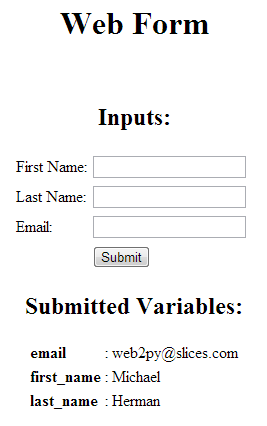CSC/ECE 517 Fall 2014/ch1a a7 ch: Difference between revisions
| Line 88: | Line 88: | ||
</pre> | </pre> | ||
[File:Webform.png] | [[File:Webform.png]] | ||
== Narration == | == Narration == | ||
Revision as of 04:25, 14 September 2014
Web2py Framework
Web2py is a free open source full-stack framework for rapid development of fast, scalable, secure and portable database-driven web-based applications written in Python.[1]
Background
Web2py was originally introduced as a teaching tool to used to demonstrate ease of use and deployment. It was modeled after Ruby on Rails and Django, and as such focuses on rapid development and adheres to the Model View Controller architecture pattern.
Here are some of the features of Web2py[2][3]:
- Web2py runs on Windows, Mac, Unix/Linux, Google App Engine, Amazon EC2, and almost any web hosting via Python 2.5/2.6/2.7/pypy, or Java with Jython.
- Accessible anywhere, without any installation required
- Open source licensed under the GNU LGPL v3.0 License
- Support for mutiple databases including: SQLite, PostgreSQL, MySQL, MSSQL, FireBird, Oracle, IBM DB2, Informix, Ingres, and Google App Engine
- Equipped with a Data Abstraction Layer that removes the requirement of knowing how to write SQL by doing it for you in real-time
- Role-based authorization of resources
- Error logging and ticketing system
- An web-based administrative interface for ease of interaction
Examples
There are several websites currently powered by Web2py, including a website hosting the ever-popular game Minesweeper.
As previously mentioned, Web2py doesn't require that you install anything, you may access and demo the capabilities online through their demo administrative interface. At the time of this article's writing, the save demo is not fully-functional.
You may download and run web2py by following the instructions on this page.
Code Examples
A complete list web2py-provided examples can be found here.
Hello World
Creating a web2py application can be as simple as writing a few lines in a single controller file (default.py):
def index(): return "Hello World"
File Upload[3]
In the Model:
db=DAL('sqlite://storage.db')
db.define_table('image',
Field('name', notnull=True),
Field('file','upload'))
In the Controller:
def index():
form = SQLFORM(db.image).process()
if form.accepted:
response.flash = 'image uploaded'
return locals()
In the View:
{{extend 'layout.html'}}
<h1>Image upload form</h1>
{{=form}}
Forms
In the Model:
db = DAL('sqlite://webform.sqlite')
db.define_table('register',
Field('first_name', requires=IS_NOT_EMPTY()),
Field('last_name', requires=IS_NOT_EMPTY()),
Field('email', requires=IS_NOT_EMPTY()))
In the Controller:
def display_your_form():
form = SQLFORM(db.register)
return dict(form=form)
In the View:
<center>
<br /><br /><br />
<h1>Web Form</h1>
<br />
<h2>Inputs:</h2>
{{=form}}
<h2>Submitted variables:</h2>
{{=BEAUTIFY(request.vars)}}
</center>
Narration
Architecture
Comparison to other Frameworks
Helpful Links
References
1. http://www.web2py.com/init/default/index
2. http://en.wikipedia.org/wiki/Web2py
3. http://www.web2py.com/init/default/what
4. http://wiki.expertiza.ncsu.edu/index.php/CSC/ECE_517_Fall_2013/oss_SocialMediaFeeds
